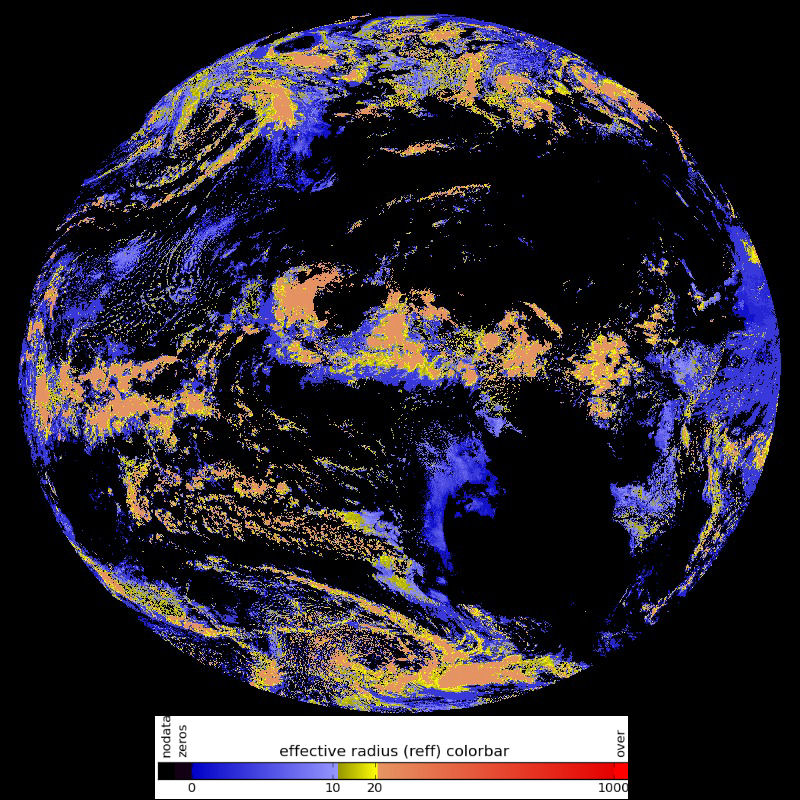
| Cloud
Microphysics PGE15 SAFNWC Table of contents 1.- Goal
of CMIC product |
Access to "Algorithm Theroretical Basis Document for Cloud Products Processors of the NWC/GEO" for a more detailed description. |
 |
|
The cloud Microphysics (CMIC), developed within the SAF NWC context, aims to support nowcasting applications. The main objective of this product is to provide detailed information on the cloud microphysics. It may be used as input to an objective meso-scale analysis (which in turn may feed a simple nowcasting scheme), as an intermediate product input to other products (such as precipitation), or as a final image product for display at a forecaster desk. The CMIC product is useful for the identification of precipitation clouds and useful for characterisation of rapidly developing thunderstorm.
The CMIC product contains information on the cloud top microphysics
for all pixels identified as cloudy in the satellite scene.
2.- CMIC algorithm summary description
The cloud top phase is first retrieved by an empirical use of T8.7µm-T10.8µm, T10.8µm and the CT cloud type itself complemented by an combined analysis of 0.6µm and 1.6µm measured and simulated reflectances, as summarized below:
Once the cloud phase has been determined, the optical depth and the particle size are obtained using the measured and the simulated 0.6µm and 1.6µm reflectances (only in daytime conditions).
Finally liquid and ice water path are obtained from optical depth and the particle size by empirical formula (only in daytime conditions).
Mandatory inputs are flagged, whereas the impact of missing non-mandatory
data on the processing are indicated.
The following satellite brightness temperatures and radiances are needed at
full IR spatial resolution:
| R0.6µm |
R1.6µm |
T8.7µm |
T10.8µm |
| Mandatory |
Mandatory |
Mandatory |
Mandatory |
The CMIC software checks the availability of satellite brightness temperatures and radiances for each pixel. Full CMIC product is computed only if all mandatory satellite radiances and brightness temperatures are available.
The satellite channels are input by the user in HRIT format, and extracted
on the processed region by NWC/GEO software package.
The CT and CTTH cloud categories are mandatory. They are computed by the
CT and CTTH software.
This information is mandatory. It is computed by the CMIC software itself,
using the definition of the region and the satellite characteristics.
The forecast fields of the following parameters, remapped onto satellite
images, are used as input :
These remapped fields are elaborated by the NWC/GEO software package from the NWP fields input by the user in GRIB format.
The NWP fields are not mandatory. The CMIC software replaces missing NWP fields by climatological values extracted from ancillary dataset. The quality of CMIC is slightly lower if NWP fields are missing.
The following ancillary data, remapped onto satellite images, are mandatory
:
These ancillary data are available in the NWC/GEO software package at a global scale; They
are remapped on the satellite disk by NWC/GEO remapping functionality.
One coefficients file (also called threshold table), containing satellite-dependent values and look-up tables for thresholds, is available in the NWC/GEO software package, and is needed by the CMIC software.
One file (netcdf format) containing offline DISORT simulations of 0.6µm and 1.6µm cloud radiative properties (beam bi-directional reflection, beam direct transmission, beam diffuse transmission, diffuse transmission, diffuse reflection flux) performed for a set of water and ice clouds, is available in the NWC/GEO software package, and is needed by the CMIC software.
The CMIC software has been designed to allow the processing at satellite IR full spatial resolution of any rectangular areas defined by the user inside the MSG full disk (the processing of the MSG full disk is also possible). The validity of the CMIC product is commited inside the MSG full disk.
5.-Description of CMIC outputs
CMIC products are coded in NetCdF and includes:
| FillValue | non-processed | containing no data or corrupted data |
| 1 | liquid | |
| 2 | ice | |
| 3 | mixed | |
| 4 | cloud free | |
| 5 | undefined | separability problem |
Cloud phase is available for all illuminations whereas all the other quantities are computed ony in daytime conditions.
It is important to note that the CMIC product is not just images, but numerical data. At first hand, the CMIC is rather thought to be used digitally (together with the appended quality flags) as input to mesoscale analysis models, objective Nowcasting schemes, but also in the extraction of other SAFNWC products such as precipitation.
Colour palettes are included in CMIC NetCdF files, thus allowing an easy visualisation of cloud top effective radius (as illustrated on the SEVIRI example), optical thickness, phase, liquid and ice water path.
| SEVIRI CMIC cloud cloud top effective radius using the colour palette
included in CMIC NetCdF files. |